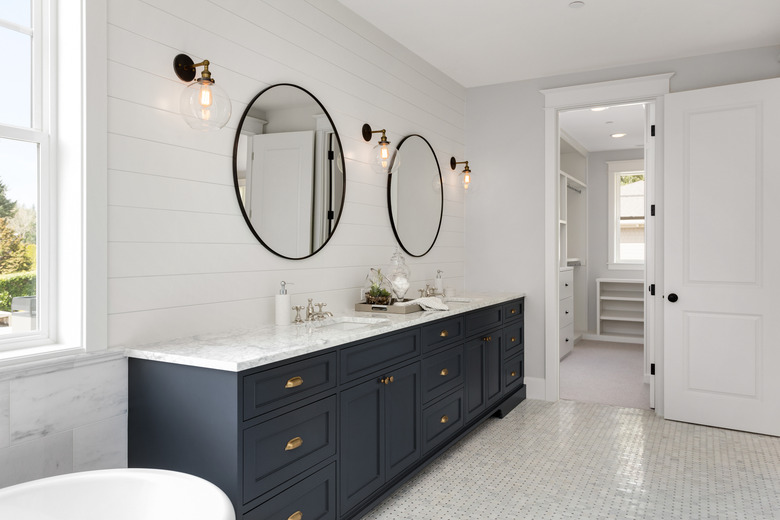The Best Materials For A Bathroom Ceiling
We may receive a commission on purchases made from links.
The National Kitchen and Bath Association has established guidelines for bathroom ceiling height, which should be at least 80 inches. But at that height — or even up to 85 inches — a ceiling is prone to getting splashed on in a shower area and calls for a highly water-resistant material like tile. Other areas of the bathroom don't need any special materials on the ceiling, but a good mold-resistant paint never hurts.
Using Cementboard for Wet Areas
Using Cementboard for Wet Areas
If you're tiling any ceiling in your bathroom, start with cementboard or another type of tile backer rated for wet areas. Do not use conventional or even water-resistant drywall behind tile in wet areas. Tile is highly water-resistant, but it's not waterproof. Water vapor can pass through tile grout, and any cracks in grout or tiles or breaches in a caulk joint allow water to get to the tile backer, or substrate.
Cementboard and other appropriate backer materials do not break down with moisture, whereas drywall turns to mush when it gets wet. However, cementboard is not impervious to water — moisture can pass through it — so it's important to protect the framing behind the board with a moisture barrier, such as plastic sheeting.
Drywall and Greenboard
Drywall and Greenboard
Conventional drywall is commonly used for ceilings in non-shower/tub areas of bathrooms, although some builders prefer to use moisture-resistant drywall — aka greenboard — instead. Moisture-resistant drywall is similar to standard drywall but has face paper that's treated for extra resistance to mold and moisture. Some manufacturers also treat the gypsum core of the material. If you'd feel better using moisture-resistant drywall on your ceiling, that alone might be worth the extra expense; it costs more than standard drywall, but installation and finishing are the same.
Not all "greenboard" is green. Moisture-resistant drywall comes in other colors, including purple. It also goes by many different names, so be sure to read the fine print to get the product with the performance factors you're looking for.
Choosing Bathroom Paint
Choosing Bathroom Paint
Outside of the shower/tub area, the biggest problem for bathroom ceilings is water vapor, which rises to the ceiling and can condense into water droplets that sit on the surface. You can control water vapor with proper ventilation, but the ceiling will still get damp. The best protection for a drywalled ceiling is a good paint job.
Ceilings in your home's living spaces are likely painted with flat paint, which cuts down on glare and hides imperfections in the surface. But flat paint lacks moisture-resistance and is difficult to clean. In a bathroom, semi-gloss or satin paint is a better choice. Semi-gloss is the shinier of the two and offers a bit more moisture-resistance, but it also comes with more glare and can show imperfections, such as drywall seams and bumps, more readily than satin. Whichever sheen you choose, it's a good idea to use paint with mildewcide to resist mold growth.
Moldings for Moisture
Moldings for Moisture
While solid-wood molding can work in non-shower/tub areas of a bathroom, alternative materials offer the best moisture-resistance for any area. Plastic or PVC moldings look just like ordinary wood molding and can be cut, installed and painted using the same techniques. Do not use medium-density fiberboard (MDF) molding or similar composite materials in bathrooms. When painted they're usually OK, but if a nail hole or open joint exposes the core of the material, moisture will quickly promote swelling and deterioration.
Ventilation Is Key
Ventilation Is Key
Ventilation is the ticket to the longevity for any type of bathroom ceiling material. If your bathroom lacks ventilation, add a good-quality vent fan rated for the size of the entire bathroom. Run the fan during and after each shower or bath until the air returns to a normal humidity level.
